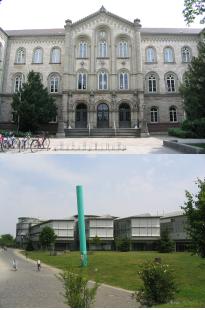|
|
Template:Infobox German University The Georg-August University of Göttingen (Georg-August-Universität Göttingen, often called the Georgia Augusta) was founded in 1734 by George II, King of Great Britain and Elector of Hanover, and opened in 1737. It rapidly attained a leading position, and in 1823 its students numbered 1547. It started with four faculties and soon became one of the best-attended universities in Europe with its 800 students.
| Contents |
History
Political disturbances, in which both professors and students were implicated, lowered the attendance to 860 in 1834. The expulsion in 1837 of the famous seven professors - Die Göttinger Sieben - viz, the Germanist, Wilhelm Eduard Albrecht (1800-1876); the historian, Friedrich Christoph Dahlmann (1785-1860); the orientalist, Georg Heinrich August Ewald (1803-1875); the historian, Georg Gottfried Gervinus (1805—1875); the physicist, Wilhelm Eduard Weber (1804-1891); and the philologists, the brothers Jakob Grimm (1785-1863), and Wilhelm Grimm (1786-1859),--for protesting against the revocation by King Ernest I of Hanover of the liberal constitution of 1833, further reduced the prosperity of the university.
The events of 1848, on the other hand, told somewhat in its favour; and, since the annexation of Hanover in 1866, it was carefully fostered by the Prussian government. In 1903 its teaching staff numbered 121 and its students 1529.
Ludwig Prandtl joined the university in 1904, and developed it into a world leader in fluid mechanics and aerodynamics over the next two decades. By the 1920s it was unparalleled, and eventually turned into the Kaiser Wilhelm Institute for Fluid Mechanics. Many of Prandtl's students went on to make some of the fundamental contributions to aerodynamics, and read like a "who's who" guide to the field.
The "great purge" of 1933
In the 1930s, the university became a focal point for the Nazi crackdown on "Jewish physics", as represented by the work of Albert Einstein and Niels Bohr (both Jewish). In what was later called the "great purge" of 1933, academics including Max Born, Victor Goldschmidt, James Franck, Eugene Wigner, Leo Szilard, Edward Teller, and John von Neumann were expelled or fled. The legacy of greatness in mathematics, a lineage which had included Carl Friedrich Gauss and Bernhard Riemann, was broken.
Though David Hilbert remained, by the time he died in 1943, the Nazis had essentially gutted the university, as many of the top faculty were either Jewish or had married Jews. When Bernhard Rust asked him if the institute had "suffered so much" from the purge, he replied, "Suffered? No, Herr Minister, it didn't suffer. It simply no longer exists." Today, Göttingen is a regular regional university in Germany, with a respectable, but no longer world-famous, mathematics department.
Current status
Göttingen_Aula_2005.jpg
Today the university consists of 13 faculties. About 24,000 students are currently enrolled. More than 2,500 professors and other academics presently work at the University, assisted by a technical and administrative staff of about 8,000. The post-war expansion of the University led to the establishment of a new, modern 'university quarter' in the north of the town. The architecture of the old university can still be seen in the Auditorium Maximum (1826/1865) and the Great Hall (1835/1837) on the Wilhelmsplatz.
Closely linked with the university are the State and University Library of Lower Saxony with its 3.5 million volumes and precious manuscripts, the Academy of Sciences, originally founded as the 'Royal Society for Sciences', and the four research institutes of the Max Planck Society for the Promotion of Science.
The international reputation of the university was founded by many eminent professors who are commemorated by statues and memorial plaques throughout the town. For example, in the 19th century, Carl Friedrich Gauss and the brothers Grimm taught there. More recently, forty-two Nobel Prize laureates studied or taught in Göttingen and many students attained a place in history – for example Otto von Bismarck, who studied in Göttingen in 1833 and lived in a tiny house on the "Wall" (according to oral tradition, he lived there because his rowdiness had caused him to be banned from living within the city walls), now known as "Bismarck Cottage," and the American J.P. Morgan.
The University Campus is divided between several locations around the city: The central University complex with the main library and 'Mensa' is located right next to the city and comprises the faculties for Law, Economy, Theology and Linguistics. Closely associated with it are the faculties for Psychology, Ethnology and Educational Sciences as well as the Medical Faculty with its associated hospitals. Just north of the city a new scientific center has been built in which most of the natural sciences (Chemistry, Microbiology, Plant Pathology, Agronomy, Forestry, Geology and Physics) are now located, including the GZMB. Other institutes are set around the inner city. The University offers eight cafeterias and six 'Mensae' (canteens) serving lunch at low prices for the students, one 'Mensa' also providing dinner.
External links
- University home page (http://www.uni-goettingen.de/?lang=en)
- Shame at Göttingen (http://www.childrenofthemanhattanproject.org/HISTORY/H-02b.htm), detailing the 1933 purge
| Coimbra Group (of European research universities) | 
|
|---|---|
| Aarhus | Barcelona | Bergen | Bologna | Bristol | Budapest | Cambridge | Coimbra | Dublin | Edinburgh | Galway | Geneva | Göttingen | Granada | Graz | Groningen | Heidelberg | Jena | Kraków | Leiden | Leuven | Louvain | Lyon | Montpellier | Oxford | Padua | Pavia | Poitiers | Prague | Salamanca | Siena | Tartu | Thessaloniki | Turku I | Turku II | Uppsala | Würzburg | |
ko:괴팅겐 대학교 id:Georg August University of Göttingen ja:ゲッティンゲン大学 no:Georg-August-Universität zh:哥廷根大学

